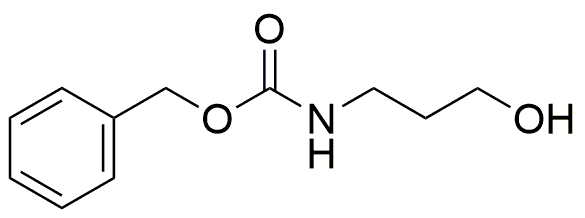3-(Benzyloxycarbonylamino)-1-propanol is widely utilized in research focused on:
- Pharmaceutical Development: This compound serves as a key intermediate in the synthesis of various pharmaceuticals, particularly in the development of drugs targeting neurological disorders.
- Bioconjugation: It is used in bioconjugation processes, allowing researchers to attach biomolecules to surfaces or other compounds, enhancing drug delivery systems.
- Peptide Synthesis: The compound plays a significant role in peptide synthesis, providing a protective group that facilitates the formation of complex peptide structures.
- Research in Organic Chemistry: It is a valuable reagent in organic chemistry for creating derivatives and studying reaction mechanisms, aiding in the understanding of chemical behavior.
- Cosmetic Formulations: The compound is explored in cosmetic formulations for its potential benefits in skin care products, offering moisturizing properties and improving product stability.
Informations générales
Propriétés
Sécurité et réglementation
Applications
3-(Benzyloxycarbonylamino)-1-propanol is widely utilized in research focused on:
- Pharmaceutical Development: This compound serves as a key intermediate in the synthesis of various pharmaceuticals, particularly in the development of drugs targeting neurological disorders.
- Bioconjugation: It is used in bioconjugation processes, allowing researchers to attach biomolecules to surfaces or other compounds, enhancing drug delivery systems.
- Peptide Synthesis: The compound plays a significant role in peptide synthesis, providing a protective group that facilitates the formation of complex peptide structures.
- Research in Organic Chemistry: It is a valuable reagent in organic chemistry for creating derivatives and studying reaction mechanisms, aiding in the understanding of chemical behavior.
- Cosmetic Formulations: The compound is explored in cosmetic formulations for its potential benefits in skin care products, offering moisturizing properties and improving product stability.
Documents
Fiches de données de sécurité (FDS)
La FDS fournit des informations de sécurité complètes sur la manipulation, le stockage et l’élimination du produit.
Spécifications du produit (PS)
Le PS fournit une description complète des propriétés du produit, notamment sa composition chimique, son état physique, sa pureté et les exigences de stockage. Il détaille également les plages de qualité acceptables et les applications prévues du produit.
Certificats d'analyse (COA)
Recherchez des certificats d'analyse (COA) en saisissant le numéro de lot du produit. Les numéros de lot et de lot se trouvent sur l'étiquette d'un produit, après les mots « Lot » ou « Lot de fabrication ».
Numéro de catalogue
Numéro de lot/série
Certificats d'origine (COO)
Ce certificat d'exploitation confirme le pays dans lequel le produit a été fabriqué, et détaille également les matériaux et composants utilisés et s'il est issu de sources naturelles, synthétiques ou autres sources spécifiques. Ce certificat peut être requis pour les douanes, le commerce et la conformité réglementaire.
Numéro de catalogue
Numéro de lot/série
Fiches de données de sécurité (FDS)
La FDS fournit des informations de sécurité complètes sur la manipulation, le stockage et l’élimination du produit.
DownloadSpécifications du produit (PS)
Le PS fournit une description complète des propriétés du produit, notamment sa composition chimique, son état physique, sa pureté et les exigences de stockage. Il détaille également les plages de qualité acceptables et les applications prévues du produit.
DownloadCertificats d'analyse (COA)
Recherchez des certificats d'analyse (COA) en saisissant le numéro de lot du produit. Les numéros de lot et de lot se trouvent sur l'étiquette d'un produit, après les mots « Lot » ou « Lot de fabrication ».
Numéro de catalogue
Numéro de lot/série
Certificats d'origine (COO)
Ce certificat d'exploitation confirme le pays dans lequel le produit a été fabriqué, et détaille également les matériaux et composants utilisés et s'il est issu de sources naturelles, synthétiques ou autres sources spécifiques. Ce certificat peut être requis pour les douanes, le commerce et la conformité réglementaire.

